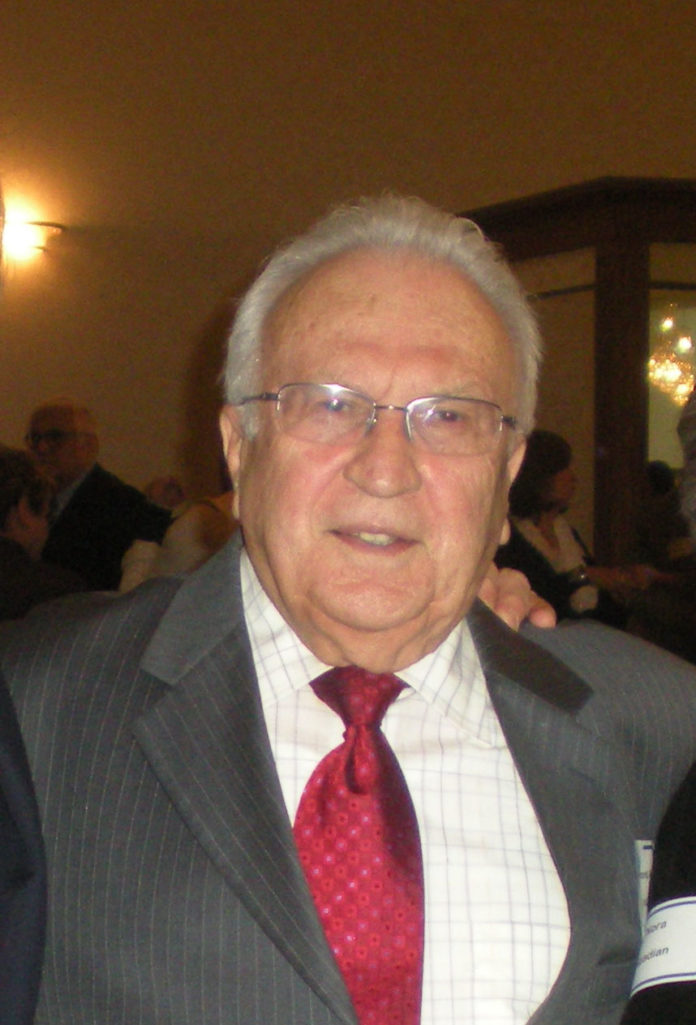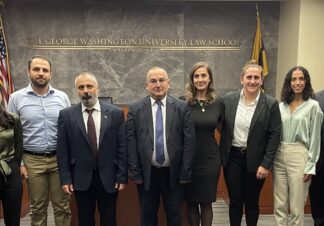By Edmond Y. Azadian
Two major events that took place one hundred years ago are being treated almost silently, although their reverberations affect the world until today.
One of those events was the October Revolution of November 8, 1917 and the other, the Balfour Declaration of November 2, 1917.
Although outwardly it seems they have no relevance to Armenian life and history, in fact, they have affected the lives and the history of Armenia and Armenians profoundly.
The October Revolution sought a fair economic system instead of the feudal one existing in Russia. It was inspired by Karl Max’s theory of revolutionary socialism, and was propelled and implemented by Vladimir Lenin.
Marx’s theory advocates that the proletariat overthrow the yoke of the capitalist structures within a society to take over communal ownership and governance of the means of production and eventually establish a society without class divisions.
The theory was simplified for popular appeal, like Jesus’ parables, to catch the imagination of the masses in a conflagration.
The motto was: “From each according to his capacity to each according to his needs.”
This simplistic philosophy was to be imposed over the society by the government, actually by the government of the proletariat.
The Industrial Revolution had modernized the production of goods and services in Europe, leading to a greater disparity in income distribution. Marx’s theory was developed based on the premises of economic life in Europe rather than the feudal system of Russia.
Despite the revolutions that took place in several European countries in 1848, none of them came to adopt socialism as imagined by Karl Marx.
The irony was that Marx’s theories took root in Russia, in a backward agrarian society where the means of production did not match those of Europe, nor were production of goods and services in abundance. Thus, the misapplication of the theory to the reality on the ground was doomed since its inception. But the theory and the implementation of that theory were forced on the Russian people and the experiment of a social laboratory began, with awful consequences for the people and for humanity as a whole.
After 70 years of experimentation, the theory ran out of steam and the structure that it had developed — the Soviet Union — collapsed on its own, without any shots fired from outside enemies.
Armenia became entangled with this huge social experiment because it had been part of the former Tsarist empire. It had hardly attained independence in 1918 when Soviet forces overran former territories on the periphery of the empire.
For 70 years, the life of the people in Soviet Armenia was shaped by this system. Armenians shared the terror of Stalin’s rule as they sacrificed 300,000 males during World War II in defense of the homeland, far more proportionately to their number in the Soviet Union.
On the other column of the balance, Armenia shared the phenomenal economic development of the Soviet Union; industry, science, arts, literature developed at a rapid rate and rural Armenia moved to the threshold of the space age.
One restrictive, negative factor, ironically, worked in favor of the Armenians: that of a travel ban. Indeed, Armenians historically and instinctively have a propensity to abandon their historic homeland to make other countries prosper — the population was forced to live on the land and maybe for the first time in history, 4.5 million Armenians lived together and developed a common national consciousness. The attraction of a burgeoning homeland became so compelling that almost 200,000 Armenians before and after World War II repatriated from the diaspora.
After the collapse of the Soviet Union, the floodgates of emigration opened wide and no one to this day has devised a policy to stop the population hemorrhage. Thus, one of the ills of the Soviet system became a blessing for Armenia, sealing its future.
The other event whose centennial is being marked this year has a more indirect impact on Armenian life, or to be more specific, on the Armenian Diaspora. That is the Balfour declaration of 1917.
After centuries of persecution in Europe and Russia, the Jews sought to establish a homeland. A Viennese journalist, Theodor Herzl, came up with the ideology of Zionism to inflame the imagination of Jews scattered around the world. They were offered by the British a vacant piece of land in Africa, and one in Russia by Stalin in later years.
But the goal of the Zionists was to repatriate to their historic homeland in Palestine. Eventually, Herzl’s dream was realized in 1948.
Chaim Weizmann, a British scientist and a Zionist leader, and Louis Brandeis, a US Supreme Court Justice, were instrumental in bringing about the issuance of the declaration by the British Foreign Secretary Lord Arthur James Balfour, who on November 2, 1917, wrote to the leader of the Zionist Federation Lord Walter Rothschild: “His Majesty’s Government view with favor the establishment in Palestine of a national home for the Jewish people and will use their best endeavors to facilitate the achievement of this object, it being clearly understood that nothing shall be done which may prejudice the civil and religious rights of existing non-Jewish communities in Palestine or the rights and political status enjoyed by Jews in any other country.”
Later on, the declaration was relegated to the League of Nations for implementation.
In the 1930s, while Britain maintained its mandate over Palestine, the British government tried to opt out of the commitment, but it was too late. The Jews had already begun repatriating from around the world, starting agricultural communities (kibbutzes).
Jewish armed insurrection had already begun in Palestine against the British occupation and the local Arab population. The King David Hotel in Jerusalem, which was the British headquarters, was blown up in 1946 and a campaign against the Palestinians was launched. Massacres like Deir Yassin and other areas intended to terrorize the local population. Lehi, the paramilitary organized group of militants, was no different than the Palestine Liberation Organization or Hamas. David Ben-Gurion, Yitzhak Shamir, and Menachem Begin were instrumental in carrying out those raids. They were leaders who later became respected statesmen.
When Israel declared independence, Armenians had to empathize with the Jewish people who had suffered the same historic trauma.
As to the caveat in the Balfour Declaration to observe the “civil and religious rights of existing non-Jewish communities,” it suffices to say that 700,000 Palestinians were deported from their land and today 1,500 Armenians remain from a community of 25,000. On the day of independence, the Jewish population was 600,000. Today the population is 8 million.
What was the liberation of the Jewish people was the nakba (catastrophe) for the Palestinian people.
The conflict and the controversy continue to this day and they have spilled out onto the Middle East.
Egypt fought three major wars with Israel until the late Anwar Sadat signed a peace agreement with his Israeli counterpart, Menachem Begin, in 1979. By that time, the affluent Armenian community in Egypt had dwindled from 55,000 to 4,000.
Since 1948, the Middle East has been a war zone. The Israeli-Palestinian conflict has mushroomed to become a global issue and Europe’s and especially the US’s unilateral support of Israel has pitted the Islamic world against the West, relegating an innocent bystander’s position to Israel.
The 1982 invasion of Lebanon by Ariel Sharon decimated the Palestinian forces there, and scared away one of the most stable Armenian communities in the diaspora. The later invasion and occupation of Iraq destroyed the local Armenian community, similar to the one that followed in Syria.
The Armenians have suffered unintended consequences from the wars, sustaining collateral damage.
Armenians from all the prosperous Middle Eastern countries flooded into Europe and the US, bringing fresh blood to these communities in the West. But on balance, the damage is much higher than the benefits.
Very few people are marking this week those two centennials. Armenians have a saying: “The fire burns where it hits.”
Two muted centennials and one destiny: the Armenian destiny.
Community
Marking Two Centennials Impacting Armenian Life
Top 5 Articles
- Trending
- Most Viewed
- Most Commented
- Fresh Lavash and Armenian Delights at Gyumri in Watertown
- Why Is the Biden Administration Whitewashing Azerbaijan’s Crimes?
- Major Ethiopian Exhibit Comes to Massachusetts Including Armenian Artifacts
- Pashinyan Ally Advocates ‘Verification’ of Armenian Genocide Victims
- Key Takeaways from an Interview with US Ambassador Kvien
- US and European Aid Package to Armenia Is Not Only Cheap, It’s Dangerous
- Valerian Markarov: Writing Russian and Being Armenian in Georgia
- California Armenian Legislative Caucus Foundation Announces Scholarships in Remembrance of the Armenian Genocide
- Recipe Corner: Kohar Avakian’s Cherished Family Recipe for Tutum
- Recipe Corner: Zatiki Chorek: Armenian Easter Bread
- Why I Am Grateful to Erdogan, the Dictator of Turkey
- A Political Whirlwind Engulfs Nagorno Karabakh
- Libya’s Interim Government Recognizes the Armenian Genocide Once Again
- Robert Bedrosian Marries High Tech With Ancient Armenian Manuscripts
- Aleppo Aid through St. Kevork Armenian Apostolic Church of Houston









